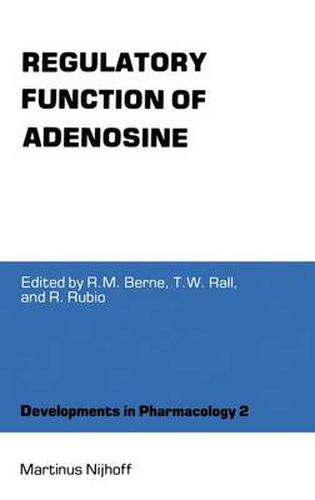Readings Newsletter
Become a Readings Member to make your shopping experience even easier.
Sign in or sign up for free!
You’re not far away from qualifying for FREE standard shipping within Australia
You’ve qualified for FREE standard shipping within Australia
The cart is loading…






This title is printed to order. This book may have been self-published. If so, we cannot guarantee the quality of the content. In the main most books will have gone through the editing process however some may not. We therefore suggest that you be aware of this before ordering this book. If in doubt check either the author or publisher’s details as we are unable to accept any returns unless they are faulty. Please contact us if you have any questions.
The principal objective of this symposium was to bring together investigators from all over the world who work in diverse areas of research but share a common interest in the physiologic and pathophysiologic funetions of the nueleoside adenosine. In 1978, the International Conference on Physiological and Regulatory Funetions of Adenosine and Adenine Nueleotides, held in Banff, Canada, served as an effective catalyst in enabling scientists with differ ent points of view to exchange information and ideas on this subject. Since 1978, the amount of research on different as peets of adenosine metabolism, mechanism of action, transport, and function in various tissues (in both nor maI and abnormal states) has increased exponentially, and there was an urgent need for another meeting for updating information on this burgeoning subject. The focus of the meeting was extremely sharp, but the scope of the subject material was very broad. Scientists categorized as chemists, biochemists, physiologists, pharmacologists, and immunologists, working with cells and eelI fragments, with tissues such as heart, brain, musele, fat, kidney, and with human beings having immune deficiency diseases participated in the sym posium. They had an opportunity to air their differences, reinforce their areas of agreement, and, most important, they educated each other with respeet to research on adenosine; it is hoped that they also enriched their own research programs from the information they gained from their fellow participants.
$9.00 standard shipping within Australia
FREE standard shipping within Australia for orders over $100.00
Express & International shipping calculated at checkout
This title is printed to order. This book may have been self-published. If so, we cannot guarantee the quality of the content. In the main most books will have gone through the editing process however some may not. We therefore suggest that you be aware of this before ordering this book. If in doubt check either the author or publisher’s details as we are unable to accept any returns unless they are faulty. Please contact us if you have any questions.
The principal objective of this symposium was to bring together investigators from all over the world who work in diverse areas of research but share a common interest in the physiologic and pathophysiologic funetions of the nueleoside adenosine. In 1978, the International Conference on Physiological and Regulatory Funetions of Adenosine and Adenine Nueleotides, held in Banff, Canada, served as an effective catalyst in enabling scientists with differ ent points of view to exchange information and ideas on this subject. Since 1978, the amount of research on different as peets of adenosine metabolism, mechanism of action, transport, and function in various tissues (in both nor maI and abnormal states) has increased exponentially, and there was an urgent need for another meeting for updating information on this burgeoning subject. The focus of the meeting was extremely sharp, but the scope of the subject material was very broad. Scientists categorized as chemists, biochemists, physiologists, pharmacologists, and immunologists, working with cells and eelI fragments, with tissues such as heart, brain, musele, fat, kidney, and with human beings having immune deficiency diseases participated in the sym posium. They had an opportunity to air their differences, reinforce their areas of agreement, and, most important, they educated each other with respeet to research on adenosine; it is hoped that they also enriched their own research programs from the information they gained from their fellow participants.